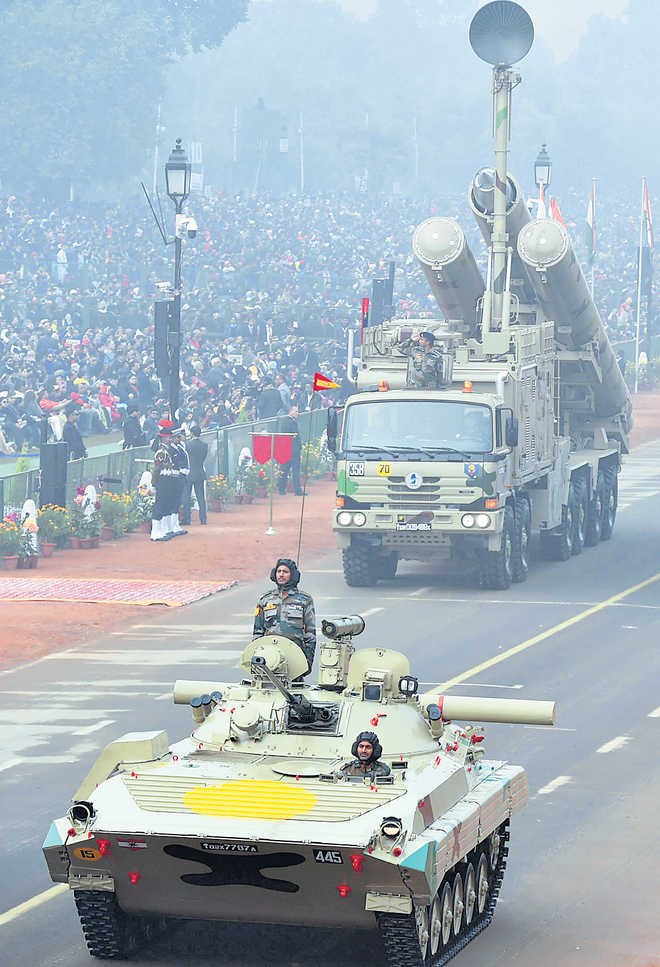
Air Marshal RS Bedi (retd)
Former Director-General, Defence Planning Staff
SO far as the allocation of funds for the defence forces is concerned, this year has been no different from the previous ones. Notwithstanding the urgency of matching the country's military profile with some of our belligerent neighbours, the government hasn't quite come up to the expectations. Whatever be the arguments in favour of the projections made by the services/MOD, the general tendency on part of the government is to allocate only in the region of 55 to 65 per cent of the projections. The allocation of Rs 2,95,511 crore for the ensuing fiscal over the current year's Rs 2,74,114 crore is tantamount to a mere increase of Rs 21,397 crore, a moderate hike of just 7.81 per cent.
This includes the capital outlay of Rs 99,563 crore meant for procurement, modernisation etc. With a large number of platforms for the Air Force and the Navy and multiplicity of other weapon systems for all the three services pending procurement, an increase in capital outlay of the order of Rs 13,075 crore seems equally moderate.
Capital outlay is rarely fully utilised every time is one argument advanced for restricted allocations at the BE (Budget estimate) stage. It is not fully utilised for reasons of complex procurement procedures, long-drawn negotiations, political constraints and devious other such factors. The fact that it also includes the time-consuming process of land acquisition and construction works also adds to the delay factor.
Modernisation is an inescapable necessity to keep pace with the adversary's rising potential. Despite all efforts, it continues to lag. Old and vintage platforms and weapon systems have to be replaced regularly because of their rising maintenance cost. All this takes time. In the acquisition of weapon systems, particularly involving foreign vendors, the gap between acceptance of necessity and contract signing could well take many years. The purchase of Rafale aircraft initiated in the year 2000 is yet to fructify. Factors like these lead to surrendering of capital funds on an almost regular basis. For once, the Ministry of Defence was able to utilise the entire capital outlay for the year 2017-18 whereas it had only surrendered an amount of Rs 6,886 crore during the previous year.
This may, perhaps, be one of the reasons for the government to hold back allocations at the BE stage. That is how every Finance Minister ends up saying that the government remains committed to enhancing the military's operational capabilities by ensuring requisite budgetary support when needed.
In contrast, the revenue expenditure is fully utilised invariably. It is critical to maintenance activity and defence-preparedness. But this too continues to fall short, averaging over a decade to about 17 per cent or so.
The defence allocation of 1.57 per cent of the GDP for the new fiscal is perhaps the lowest in recent years. The downward trend seems rather inconsistent with the prevalent security environment in the region. The seventh largest economy in the world growing around seven per cent has not been able to keep pace with the neighbours who continue to spend much larger amounts year after year.
The fact is that the armed forces have to continuously upgrade their wherewithal to match that of the adversary. Modernisation is nothing but acquiring the best to match what the adversary has and what is required to achieve the politico-military objective. It's a plain and simple question of competitive re-armament. India has no option but to develop capabilities that would dissuade adversaries from any undue venture.
However, when defence allocation is viewed in terms of percentage of CGE (Central Government Expenditure) and not of GDP, it presents an entirely different picture. This year's defence allocation of 12.10 per cent of CGE is almost the same as last year. In fact, it had remained by and large constant between 12 and 13 per cent during the entire decade. But when viewed as a percentage of GDP, it shows a declining trend year after year.
However, conventionally, the defence expenditure is always reflected as a percentage of GDP the world over.



























